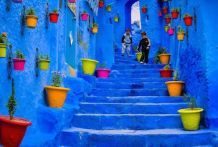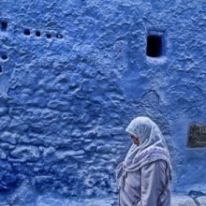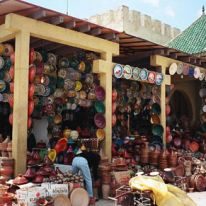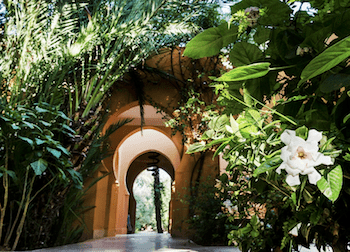
Botanical Gardens of Marrakech, An Insiders Guide of the Top 10 Medicinal Plants & Herbs
Marrakech, affectionately referred to as the “the Daughter of the Desert,” has become a cultural melting pot where the antiquated world of Kasbah culture meets modern day life. Contemporary Moroccan fashion and Moorish design set the scene and can be found hidden behind the Marrakech red hamra city walls and on the streets of Art Deco, French Gueliz. After the French colonialists left Morocco, what remained was a burgeoning society where the artsy and eclectic flourished alongside the traditional population.
Beyond trendsetting Marrakech is a world of exotic gardens with a wide range of plant life. A Taste of Paradise can be found in Marrakech’s most alluring gardens of which boast wonderful cacti, herbs, and botanical plants. Plant life in Marrakech and Morocco offers much more than just an aesthetic experience. Morocco’s dry tolerant and succulent plants permeate some of the world’s most magnificent gardens. Cacti and botanicals are used daily by Moroccan women. They are included in Moroccan teas, in beauty regimens, recipes within the Moroccan kitchen, and also revered as healing tools to ward off illnesses.
Beyond trendsetting Marrakech is a world of exotic gardens with a wide range of plant life.
We’ve pulled together an insider’s guide and some tips about the Top 10 Medicinal Plants and Herbs in Morocco and where to find them in Marrakech’s Botanical Gardens, Next time you are visiting a Marrakech Garden or are taking a drive into the countryside you will be steps ahead of other Morocco travelers with our quick insiders guide.
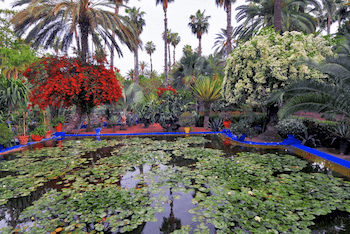
Insiders Guide to the Top 10 Most Medicinal Plants & Herbs & Where to Find them at Marrakech’s Botanical Gardens:
#1: Aloe Vera – Aloe vera is one of the most recognizable plants on this list for a reason. It is revered around the world for its healing, hydration, and anti-aging properties that penetrate the skin. While Aloe Vera is not originally from Morocco, it was brought over from North Africa and can now be found almost everywhere in Marrakech. There are bushes in front of the Yves Saint Laurent, Majorelle Gardens.
Aloe Vera can be found at the following Gardens in Marrakech:
Majorelle Gardens – Located in Gueliz, the Majorelle Gardens is home to over 1800 types of cacti, 400 species of palms and many other varieties of flora. Founded by Jacque Majorelle and designed by Yves Saint Laurent, Majorelle is the most iconic garden in Morocco. Jacques Majorelle traveled all around the world to gather inspiration for his paintings and along the way, he became a passionate botanist, bringing home different species of plants as souvenirs from far reaches of the world.
Historical Landmark Garden at La Mamounia in Marrakech – Located near the Koutoubia Mosque, the majestic garden at the famous La Mamounia Hotel where Winston Churchill had his own suite, is the stunning Menzah Pavillion set among dozens of rows of orange and lemon trees, 5,000 rose bushes, 21 cactus species, 6 palm trees species and 200 olive trees that stand in perfect lines. Aloe vera is just one of the special plants you can find at La Mamounia gardens — there are flower beds, jacarandas, bougainvillea, amaranth, agaves, prickly pear trees and more.

#2: Prickly Pear Cactus – Prickly pear is a cactus that can also be found in the Yves Saint Laurent Majorelle Gardens elaborate system of plant canals. Commonly found in Morocco, the Prickly Pear Plant is on many street corners and has become one of the most treasured plants in Morocco. Prickly Pear is a new phenomenon and now the biggest competitor of Argan oil. The extracted cactus oil that can be produced from it is sought after by many up and coming Moroccan companies who are using it to make beauty products for the local market and export.
Prickly pear grows across the grand Sahara Desert and is one of those rare plants that remain bright green even in the driest climates like the Sahara. Prickly Pears hidden secret lies within its innate cellular structure. The cactus oil produced from it is said to have the highest concentrations of Vitamin E, sterols, and omega 6 fatty acids in its seeds. The nutrients are incredible at protecting and nourishing your skin, hydrating, and fighting wrinkles and fine lines.
Two unique places where you can find high quality, effective, and pure sources of Prickly Pear serum are at the boutique, The Moroccans, a shop run by two friends inspired from their mother’s love for natural skin care methods; also the Cooperative Toudarte in Agadir with argan products made by local women is a trustworthy choice. The Moroccans are located around the corner from the Majorelle Gardens and Toudarte products can be found at the bio shop Ayaso in Gueliz.
Prickly Pair can be found at the following Gardens in Marrakech:
Anima Gardens – Described as one of the world’s most beautiful gardens for its array of colors and shades, a stroll at Anima is like walking through a painting. The breathtaking snow-capped Atlas mountains of Mount Toubkal make up the backdrop as you stroll among the shady paths, interesting trees, shrubs, blossoms, pavilions, and sculptures. This is a great garden to see Pear.
#3: Agave – There are over 1500 species of cactus that stretch from Morocco Rif Mountains in the North to the Anti Atlas in the Southern desert region. Agave is another type of cactus that is widely used for both health benefits and for the fabrication of home goods and products. It is also used as a natural sweetener. In Morocco, Agave is used to manufacture many types of beauty products and home goods. It is placed on a loom and then made into pillows, blankets, and other home items. It is referred to by many as “cactus silk.” The Some Slow Concept Store in Marrakech has a beautiful collection of pillows made from Agave. It is also used in skin conditioners and moisturizers. Additionally, agave is used as a healthy alternative to sugar. Agave is sold in Marrakech at Green Village or Ayaso Bio Shops in the Gueliz neighborhood in Marrakech. Agave along with other cacti can be found in the Historic Gardens at La Mamoumia Hotel in Marrakech.
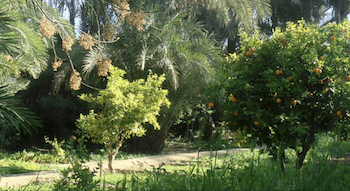
Agave can be found at the following Gardens in Marrakech:
Jnane Tamsna – Just 10 minutes from the orange clay walls of Marrakech’s 12th-century medina is the private boutique villa Jnane Tamsna. Jnane Tamsa boasts a wild garden with a palmeraie that covers a 30,000-acre territory. Hotelier Meryanne Loum-Martin discovered this oasis in the region of which today has become a favorite escape of Marrakech’s in-the-know and expats Meryanne Loum-Martin and her ethnobotanist American husband oversee a twenty-four room Garden Gallery on the property.
#4: Mint – If you ask a Moroccans about memories of their childhood, they will often share an image of their mother in the kitchen, blending together an herbal mint tea to ward off a cold or improve a family member’s digestion. With facts like these, one can better understand why you can spot mint all over Morocco. There are several different kinds of mint you will find in Marrakech’s garden and Morocco in general, however, the most common mint species is spearmint. Spearmint has a clear, pungent, and mild aroma, and Moroccans sip mint tea up to thirty times a day. There are many medicinal benefits of Moroccan Tea, especially when infused with aromatic plants with dried flowers, rose petals, lemon peel, and the herbs you can read about below.
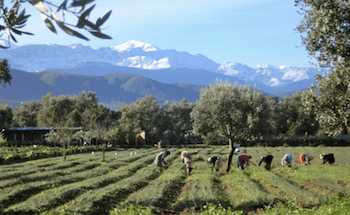
Mint can be found at the following Gardens in Marrakech:
Le Paradis du Safran (Saffron Gardens) – At the foothills of the legendary Atlas mountains lies the Ourika Valley which is also home to the Saffron Gardens. Le Paradis du Safran was is owned by Christine Ferrari, a Swiss native. The garden is well designed and cared for with love by Ferrari and a host of Berber women she employes from nearby villages. There are citrus fruit trees, lemon, lime, orange, pomegranate, grapefruit and tangerine trees. Home to over 100 herbs including spearmint, a Moroccan favorite and used in traditional mint tea. A three-course lunch is offered with a Safran base and using varied ingredients from the garden along with fresh baked Berber bread. Advance reservations required.
Mint in cosmetics: Peppermint, with it’s antibacterial, anti-inflammatory, and immune boosting properties has been recognized by many cosmetic brands in Morocco and is infused into Moroccan women’s beauty secrets. The Moroccans, a locally based brand, produce a wonderful mint and argan oil cream, specifically made to clear the complexion.
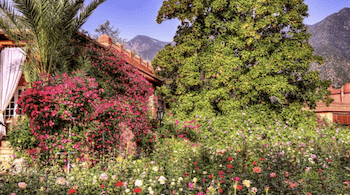
#5: Geranium – Geranium is another plant found throughout Morocco’s gardens and in the historic medina of Marrakech. Moroccans add geranium to their tea for the calming factor it induces. It is also an anti-aging ingredient used for skin and hair.
Geranium can be found at the following Gardens in Marrakech:
Gardens at Domaine de La Roserie — In the Berber region of Ouirgane, at an altitude of 1000m, sits the magical Gardens of La Roserie. The panoramic Atlas Mountain setting is sure to awaken the five senses. La Roserie is a historic, boutique hotel of well-appointed villas and one of the most scenic properties in Ourigane. It is expansive and stretches across sixty acres of parkland surrounded by flower beds, olive trees, orchards, geraniums, and rose bushes.
#6: Thyme – Thyme is revered in Morocco as a medicinal herb known for its anti-bacterial, anti-inflammatory, and antiseptic properties. It is used into bread, tagines, teas, and occasionally in sweets.
Thyme can be found at the following Gardens in Marrakech:
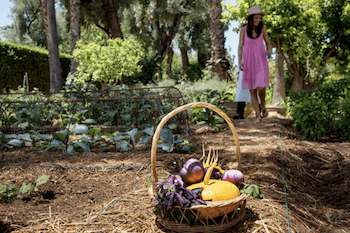
La Mamounia Hotel Vegetable Garden – La Mamounia’s Menzah Pavilion is with dozens of roses, cacti, and orange trees. It also has a 1,500 m2 of the vegetable garden. Here, the exquisite hotel’s gardeners and chefs, together cultivate aromatic plants such Moroccan thyme, coriander, fragrant verbena and Madagascar lemongrass, spices, Borji min, different species of carrots, thirteen varieties of European tomatoes leeks, beetroot, and other natural ingredients all used at La Mamounia’s Moroccan, Italian and French restaurants.
The Kasbah Demanante cooperative provides some of the finest thyme in all of Morocco. They are consistently striving to improve their batches and the health of their plants. Gueliz’s bio shop Ayaso serves tea from this Moroccan cooperative.
#7: Eucalyptus – Eucalyptus trees, renown for their aromatic value as well as their anti-inflammatory, pain reducing, and respiratory boosting properties can be discovered throughout Morocco. They are scattered throughout the cities and in the countryside. Eucalyptus trees can also be found en route to the coastal town Essaouira from Marrakech and even in the Nectarome Gardens, a bio aromatherapy garden in the Ouirka Valley.
Eucalyptus trees can be found at the following Gardens in Marrakech:

Nectarome Botanical Garden – Nectarome Gardens was the first organic, aromatic garden created in Morocco. It is 35km from Marrakech. Nectarome has many Eucalyptus trees and over fifty aromatic plants, medicinal and ornamental, predominantly originating from the region. The garden is open to the public all year long for guided visits, workshops or a footbath. Visitors can sample their botanical-infused argan oils.
#8: Rosemary – Rosemary is revered for it’s anti-inflammatory, circulation boosting and memory enhancing properties. It is also one of the most used herbs in Moroccan cuisine. Rosemary can be found in many rural regions of the Moroccan countryside and in private, villa gardens throughout Morocco.
Rosemary bushes can be found at the following Gardens in Marrakech: Botanical Gardens at La Mamounia Hotel, Nectarome Gardens in the Ourika Valley, and the Domaine de La Roserie in Ourigane are certain to have Rosemary.
#9: Bitter Sweet Orange – Anyone who visits Morocco will immediately recognize that this country is rich with orange trees. However, don’t be so quick to hand pick one of these citrus fruits for a snack. The countless rows of orange trees decorating Morocco’s palmeraies and roadsides which bring bold colors to Morocco’s famous gardens like the legendary Hotel La Mamounia in Marrakech are actually not meant for eating. These orange trees are filled with bitter orange fruit. While not tasty, bitter orange contains some of the most potent ingredients to fight cellulite, boost your metabolism, and increase focus.
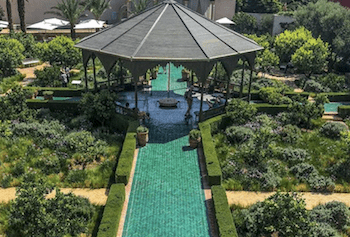
Bitter Sweet Orange trees can be found at the following Gardens in Marrakech:
Le Jardin Secret – The Secret Garden is located in a 12th century historic Marrakech. Medina. Well appointed in the Mouassine district, the origins of the complex date back to the Saadian Dynasty, more than four hundred years ago. Rebuilt in the mid-Nineteenth century at the behest of an influential Caid of the Atlas Mountains, Le Jardin Secret has been the home of some of Morocco and Marrakech’s most important political figures. It is also home to the bitter orange trees which are laced throughout the garden. As the result of a recent renovation; Le Jardin Secret is now part of the great tradition of stately Arab-Andalusian and Moroccan palaces. The gardens and buildings housed in Le Jardin Secret outstanding examples of Islamic art and architecture.
Cosmetics with Bitter Orange – A trustworthy Marrakesh based skincare company offering many products containing bitter orange is Les Sans de Marrakech. This trend-setting Marrakech brand includes Bitter Orange in everything from toners, to face wash, serums, skin exfoliators, and hand soaps. Les Sans de Marrakech has two locations, one is just around the corner from the famous Majorelle Gardens and the other in the artistic and industrial district of Sidi Ghanem. All Les Sans de Marrakech products are made with pure, ethically sourced, and safer skin ingredients.
#10; Lavender – Lavender, best known for its aromatic properties is found throughout Morocco in private home gardens, riads, and wild fields in rural regions laced throughout Morocco’s diverse terrain. Beyond a fantastic smell, Lavender is known for the ability to soothe burned or irritated skin, relax the body, induce sleep and even help reduce inflammation.
Lavender can be found at the following Gardens in Marrakech:
Botanical Gardens at La Mamounia Hotel, Nectarome Gardens in the Ourika Valley, and the Domaine de La Roserie in Ourigane are certain to have Rosemary.
Cosmetics and Teas with Lavender – The Moroccans, a trendsetting Marrakech based brand, sell an amazing lavender body exfoliant scrub. You can also make your own products with lavender from high-quality essential oils in Gueliz’s Bio Shop, Green Village and the Homeopathic Pharmacy L’Unite can provide advice on how to do this. If you would like to consume lavender, Nectarome Botanical Gardens offers a wonderful lavender tea infusion. The other option is to purchase dry loose, leaf lavender at Marrakech bio shops Ayaso or Green Village, then make your own tea.

